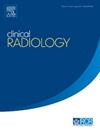Radiomics analysis of 18F-FDG PET/CT for visceral pleural invasion in non-small cell lung cancer with pleural attachment
IF 2.1
3区 医学
Q2 RADIOLOGY, NUCLEAR MEDICINE & MEDICAL IMAGING
引用次数: 0
Abstract
AIM
This study aimed to establish and validate a preoperative model that integrates clinical factors and radiomic features from 2-[18F]-fluoro-2-deoxy-D-glucose (18F-FDG) positron emission tomography (PET)/computed tomography (CT) for predicting visceral pleural invasion (VPI) in non-small cell lung cancer (NSCLC) with radiological pleural attachment.
MATERIALS AND METHODS
A total of 974 NSCLC patients (408 with VPI-present and 566 with VPI-absent) were retrospectively included from two medical centres. Clinical data and PET/CT radiomic features were collected. The optimal predictors from these radiomic features were selected to create the radiomics score (Rad-score) for the PET/CT radiomics model. Significant clinical factors and Rad-scores were incorporated into a combined PET/CT radiomics-clinical model. The predictive performance of the models was assessed using receiver operating characteristic (ROC) analysis.
RESULTS
The combined PET/CT radiomics-clinical model predicted VPI status with areas under the ROC curve (AUCs) of 0.869, 0.858, and 0.863 in the training set (n=569), internal validation set (n=245), and external validation set (n=160), respectively. These were significantly higher than the AUCs of the PET/CT radiomics model, which were 0.828, 0.782, and 0.704 (all P<0.001). In patients with a maximum tumour diameter (Dmax) ≤ 3 cm (n=537) and in patients with adenocarcinoma (n=659), the AUCs of the combined model were 0.876 and 0.877, respectively. A nomogram based on the combined model was developed, with well-fitted calibration curves.
CONCLUSION
The combined PET/CT radiomics-clinical model provides an advantage in predicting VPI status in NSCLC with pleural attachment.
18F-FDG PET/CT对胸膜附着非小细胞肺癌内脏性胸膜侵犯的放射组学分析
目的本研究旨在建立并验证一种综合临床因素和2-[18F]-氟-2-脱氧-d -葡萄糖(18F- fdg)正电子发射断层扫描(PET)/计算机断层扫描(CT)放射学特征的术前模型,用于预测胸膜附着的非小细胞肺癌(NSCLC)内脏性胸膜侵犯(VPI)。材料与方法回顾性分析了来自两个医疗中心的974例非小细胞肺癌患者(408例有vpi, 566例无vpi)。收集临床资料及PET/CT放射学特征。从这些放射组学特征中选择最佳预测因子,为PET/CT放射组学模型创建放射组学评分(Rad-score)。将重要的临床因素和rad评分纳入PET/CT放射学-临床联合模型。采用受试者工作特征(ROC)分析评估模型的预测性能。结果PET/CT放射组学-临床联合模型预测VPI状态,训练集(n=569)、内部验证集(n=245)和外部验证集(n=160)的ROC曲线下面积(auc)分别为0.869、0.858和0.863。这些均显著高于PET/CT放射组学模型的auc,分别为0.828、0.782和0.704(均为P<;0.001)。在最大肿瘤直径(Dmax)≤3cm的患者(n=537)和腺癌患者(n=659)中,联合模型的auc分别为0.876和0.877。建立了基于组合模型的nomogram,其校正曲线拟合良好。结论PET/CT放射学-临床联合模型在预测胸膜附着的NSCLC患者VPI状态方面具有优势。
本文章由计算机程序翻译,如有差异,请以英文原文为准。
求助全文
约1分钟内获得全文
求助全文
来源期刊

Clinical radiology
医学-核医学
CiteScore
4.70
自引率
3.80%
发文量
528
审稿时长
76 days
期刊介绍:
Clinical Radiology is published by Elsevier on behalf of The Royal College of Radiologists. Clinical Radiology is an International Journal bringing you original research, editorials and review articles on all aspects of diagnostic imaging, including:
• Computed tomography
• Magnetic resonance imaging
• Ultrasonography
• Digital radiology
• Interventional radiology
• Radiography
• Nuclear medicine
Papers on radiological protection, quality assurance, audit in radiology and matters relating to radiological training and education are also included. In addition, each issue contains correspondence, book reviews and notices of forthcoming events.
 求助内容:
求助内容: 应助结果提醒方式:
应助结果提醒方式:


